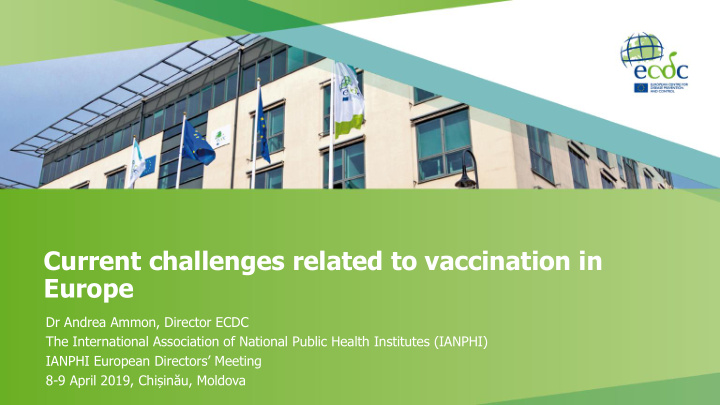



Current challenges related to vaccination in Europe Dr Andrea Ammon, Director ECDC The International Association of National Public Health Institutes (IANPHI) IANPHI European Directors’ Meeting 8-9 April 2019, Chișinău , Moldova
Policies and programmes in the EU Vaccination policies remain within the remit of EU Member States Policies vary considerably between countries: type of vaccines used, number of doses administered and timing Variation linked to social, economic, health system organisational or historical factors Differences contribute to a perception of diverging opinions on the vaccines themselves, in turn leading to growing levels of hesitancy 2
Measles - A challenging context: Current epidemiological situation and vaccination coverage in the EU/EEA 3
Six countries account for 90% of all cases
Vaccination coverage for the second dose of measles- containing vaccine, EU/EEA, 2017 5 https://ecdc.europa.eu/en/publications-data/vaccination-coverage-second-dose-measles-containing-vaccine-eueea-2017
Falling trend in reaching 95% for 2 doses of MMR in EU/EEA 6
Reasons for low coverage 7
Vaccination paradoxin the meantime? And where are we now? 1 2 3 4 5 Prevaccine Increasing Loss of Eradication Resumption of Coverage Confidence Confidence Vaccinations Disease Stopped Incidence Vaccine Outbreak Coverage Adverse Events Eradication Maturity Robert T. Chen, Suresh C. Rastogi, John R. Mullen, Scott W. Hayes, Stephen L. Cochi, Jerome A. Donlon, Steven G. Wassilak. The vaccine adverse event reporting system (VAERS). Vaccine, 1994, 12 (6): 542-550 8
Vaccine hesitancy and its determinants in Europe Source: ECDC. Rapid literature review on motivating hesitant population groups in Europe to vaccinate. Stockholm: ECDC; 2015
Hesitancy in healthcare workers in Europe Vaccine hesitancy in healthcare workers, HCWs, is present in all the countries which took part of the ECDC study Most important concern: vaccine safety Doctors have high level of trust in health authorities but mistrust pharmaceutical companies HCWs believe it is their role to respond to patient hesitancy Attitude and knowledge of HCWs can influence their vaccine uptake, their intention to recommend vaccination, and overall vaccination coverage ECDC. Vaccine hesitancy among healthcare workers and their patients in Europe – A qualitative study. Stockholm: ECDC, 2015.
Key areas and options for response 11
Council Recommendations on increased cooperation on vaccination 3 main pillars for action: Tackling vaccine hesitancy and improving vaccination coverage Sustainable vaccination policies in the EU EU coordination and contribution to global health Available at: http://data.consilium.europa.eu/doc/document/ST-14152-2018-REV-1/en/pdf 12
ECDC support to the Council Recommendation on vaccination Establish a European Vaccination Information Sharing system (EVIS) in order to: Develop guidelines for a core EU vaccination schedule, examine feasibility of common vaccination card; Strengthen consistency, transparency and methodologies for vaccines assessment together with the National Immunisation Technical Advisory Groups (NITAGs); Design EU methodologies and guidance on data requirements for better monitoring vaccination coverage in cooperation with WHO; Establish a European vaccination information portal, with the support of the European Medicines Agency, EMA; Counter on-line vaccine misinformation and develop evidence – based information tool and guidance to support Member States in responding to vaccine hesitancy. In cooperation with EMA, monitor benefits and risks of vaccines and vaccinations at EU level, including post-marketing surveillance studies. 13
Options for response Life-course approach needed; Strengthen routine immunisation: facilitate access, address concerns, and identify those who are not / are incompletely vaccinated Set up effective catch-up programmes where necessary for individuals having missed vaccination or too old to have been targeted by routine programmes Roll out and implement electronic immunisation information systems, for record-keeping but more broadly to strengthen the monitoring and performance of programmes, better assessment of vaccine coverage Strengthen the monitoring and follow-up on vaccination status of healthcare workers Empower healthcare professionals, at all levels, particularly in primary care to be effective advocates of vaccination (training in soft skills and hard skills, communication, etc.) 14
Options for response (2) Widen access opportunities and remove direct/indirect barriers (financial, structural, legal) Better partnership with other stakeholders (e.g. pharmacists but also HCPs at different levels – nurses, geriatricians, mid-wives) to raise awareness and build alliance Foster EU scientific collaboration on the assessment of evidence for decision-making on vaccination policies Develop evidence-based information and tools to counter vaccine hesitancy (e.g. online portal EU-branded; social media listening)
Final reflections on communication challenges related to vaccine hesitancy How to ensure that we maintain and strengthen our position as a trusted source of scientific information? Being proactive, facilitating access to information and scientific expertise, coordination, transparency How can we best prepare for a quickly evolving information/media landscape? Keep abreast of new developments and research, “listen”, adapt Recognising the importance of the topic and the need to allocate sufficient resources over time How to ensure that the evidence being created is effectively applied? Sharing knowledge, work with multidisciplinary teams, partnerships and cross-dissemination How can we “speak to the heart”? How to communicate differently? Value of storytelling
Thank you ecdc.europa.eu 17
Recommend
More recommend